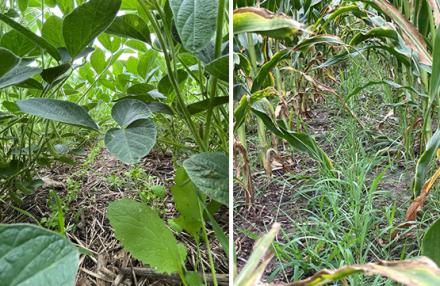New Benefits Found in Long-Term Cover Cropping
Cover cropping is becoming a popular agricultural practice to help reduce soil erosion, increase organic matter, improve early weed control, and provide forage for animals. Cover crops also benefit the environment by using residual nitrogen in the soil and, therefore, reducing nitrogen that can leach into the groundwater. They can also fix nitrogen from the atmosphere, supplying some of this valuable nutrient to the succeeding crops that reduces the rate and cost of nitrogen fertilization.
Many studies have been conducted on the short-term effects cover crops have on the soil microbiome or the health and nutrient content of soil. However, the long-term influence of cover cropping on the root microbiome of cash crops such as corn and soy has not been adequately studied.
“Cover cropping is a conservation practice that diversifies cropping systems and mitigates detrimental consequences of simplified cropping systems,” said Dr. Chuntao Yin, research microbiologist at ARS’s North Central Agricultural Research Laboratory in Brookings, SD. “However, the beneficial effects of cover crop practices are inconsistent or even contradictory, and legacy effects of cover crops on cash crop root microbiota are poorly understood.”

Yin and her colleagues conducted a study to determine the long-term effects of cover cropping on the plant’s root microbiome, as well as cash crop performance and soil health. For the study, researchers interseeded cover crops in-season in both the corn and soybean phases of the corn-soybean rotation. Winter rye was interseeded into the corn plots, and an equal mixture of winter rye, forage turnip, and three different clovers were interseeded in the soybean plots. Researchers measured six soil health indicators: potentially mineralizable nitrogen (PMN), autoclaved-citrate extractable soil protein (ACE protein), permanganate oxidizable carbon (POXC), basal respiration, mineralizable C, and beta-glucosidase activity.
“These (six indicators) are important, sensitive, and early response biological indicators for soil health changes,” Yin said. “They are widely used to monitor and assess soil property changes due to agricultural management practices or environmental changes.”
Researchers harvested the plant and soil associated with plant roots from both corn and soybean crops at the seedling and flowering stages. They found that 5 years of cover crop integration into a long-term corn-soybean rotation significantly increased average soybean yields (9.93%) and marginally increased average corn yields (4.13%), compared to no cover crop treatments. Cover cropping significantly influenced bacterial and fungal communities in the soybean roots, but did not affect bacterial and fungal communities in the corn roots.
“Five years of cover crop implementation into a long-term no-till corn-soybean rotation significantly altered soybean root microbiota while increasing soybean yield,” Yin said. “With corn, there were smaller, but positive effects, of cover crops on corn root microbiomes and corn yield.”
Researchers concluded that 5 years of cover cropping was not long enough to significantly change soil health properties in some soil types, depending on previous management. Long-term cover crop practices (7 years or longer) were often needed for greater benefits. Additionally, other factors, like reduced inorganic fertilizer inputs in plots, cover crop species, weed and volunteer plant management, and climate, may also affect the outcomes. Yin and her colleagues are planning a longer, 8-year study of cover crops to evaluate further benefits of this farming method.
“We expect to improve soil health and promote resilience to crops from a variety of abiotic (drought and flooding) and biotic (weeds, pests, and pathogens) stresses and climate change by diversifying cropping systems, including crop diversity and cover cropping,” said Yin. “This research demonstrated that cover cropping benefits cash crop root microbiomes and increases cash crop yield, and to achieve desired benefits from cover cropping, selection of cash crop and cover crop species and the duration of cover crop practices should be considered.” - By Todd Silver, ARS’s Office of Communications
To learn more, check out this podcast.

